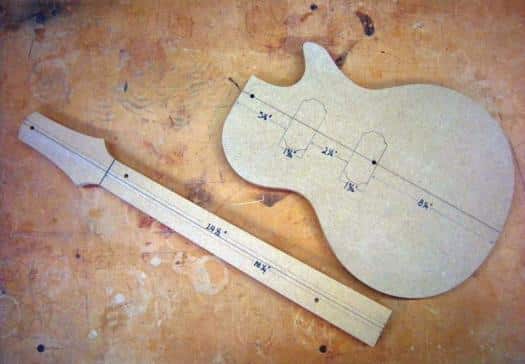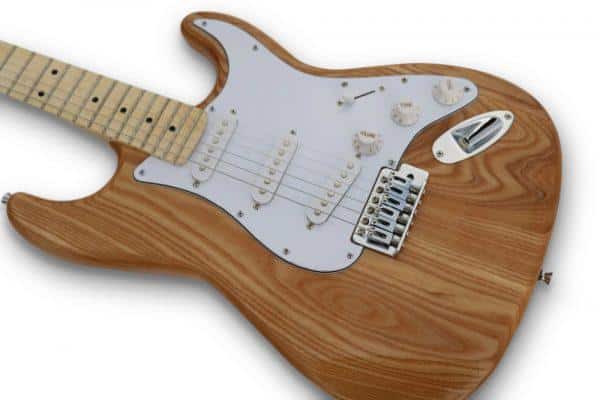It was during an unassuming jam session at a friend’s garage when one strum of a vintage Les Paul changed the trajectory of my life. My engineer-turned-luthier journey began that fateful evening, when I first held this majestic wooden electric guitar – its vibrant notes resonating within me. But it wasn’t just the charismatic melody. The fine grain pattern, the smooth edges, the solid body – they all reflected a mass of untold stories and ignited in me, a passion for these incredible crafts of art. Yet, that was just the beginning…
Wooden electric guitars have a magic of their own. The solid body wooden guitar I first played – a time-honored Les Paul – holds the credit for my transformation from an engineer to a luthier. Like a captivating book, there was something about it that made me feel a connection, a bond beyond the tangible. As though each groove, each note echoed with a song of its own. But, what was it about Wooden Electric Guitars that made them so magical?
A highly debated claim might surprise you here – the sound quality of an electric guitar does not solely rely on its electronic configuration but significantly on the body’s material. Intriguing, isn’t it? Solid wooden bodies play a stellar role in determining the quality and resonance of the sound produced. Stick around, and you’ll understand why.
I have walked the line, from a curious audience to a passionate craftsman, and this guide reflects both my journey and acquired knowledge. Along the way, I’ve learned the charmingly complex intricacies and quintessence of crafting wooden electric guitars. The chapters ahead venture deeper into understanding different aspects of these magical instruments, right from their design to the various styles worldwide.
Together, let’s embark on a journey exploring the world of wooden electric guitars, a world where craftsmanship meets art, history, and technology.
The comprehensive discourse that follows will uncloak the secrets which make the wooden electric guitar a maestro’s choice. Stay tuned to uncover the science, art, and passion that goes into the crafting of these elegant, solid body electric guitars.
Understanding Wooden Electric Guitars
Design and Construction

As an expert luthier, the process of designing and constructing a guitar is truly fascinating. I may have produced countless wooden electric guitars in my career, but there’s a unique satisfaction in exploring the intricacies of every new stringed masterpiece. To me, guitar construction isn’t just about woodworking skills; it’s also an exercise in acoustics and ergonomics.
Fundamentally, the design process begins with careful wood selection for guitars. Every species of wood resonates differently due to its unique density, rigidity, and moisture retention characteristics. Therefore, the tonewood chosen for a wooden electric guitar impacts its sustain, tone, and ultimately, its auditory personality.
The quality of the wood, its grain, and the thickness are critical parameters in crafting the guitar’s body. Notably, a dense wood adds weight, providing a richer, deeper tone, while lighter woods offer a bright, more vibrant sound.
Implementing the electric guitar design calls for a meticulous approach. The key is to achieve a delicate balance between technological considerations, including pickups, bridge, and volume controls, with ergonomic factors like comfort, ease of play, and aesthetics. After all, a well-designed guitar should resonate with both the player’s hands and their soul.
The construction phase breathes life into the guitar’s design. To create the instrument’s body, a process known as routing is carried out, where the body’s shape is carved out from the slab of chosen wood. The precision in this phase plays a pivotal role in the final outcome.
Post body-construction, one cannot underestimate the importance of fretboard crafting and neck shaping – both enhancing playability. Here, I try to harmonize precision engineering with a respect for the craft’s tradition and soul.
In conclusion, the masterpiece that lies in the hands of the guitar player is a product of thoughtful wood selection, robust science, masterful design, and outstanding craftsmanship. As we move onto our next section, ‘Different Styles’, we’ll see how these aspects of guitar construction come together to create a spectrum of wooden electric guitar styles, each with its unique voice and character.
Different Styles

As we dive deeper into different styles, my decades of crafting and playing electric guitars come to the forefront. The selection of the various components like the neck style or the choice between laminated and solid wood directly impacts a guitar’s performance.
In my experience, a maple neck electric guitar provides well-balanced sound and high-speed playability. The material provides natural sustain, a bright top end, and an ability to clearly define each note. On the other hand, if the neck is constructed from other types of wood, the tone can significantly vary.
Another critical decision is whether to choose a laminated or solid wood guitar. While laminated ones are more durable and affordable, they can’t match the superior resonance, tone consistency, and aesthetics of solid wood guitars. However, it ultimately boils down to personal preference and the sound you’re aiming to achieve.
Over the years, I’ve spent countless hours crafting handmade electric guitars. These masterpieces, crafted meticulously by hand, offer unparalleled sound quality and a distinct aesthetic. There’s just something about a custom-built guitar that feels and sounds deeply personal.
To sum up, the choice of style greatly influences the performance and tone of wooden electric guitars. Your understanding of these different aspects will enable you to make more informed decisions. And remember, there’s no right or wrong choice – it is all about finding the right guitar style that resonates with you and your music. As we progress to the next section, I will explain the various factors and techniques involved in construction, bringing us even closer to completing our comprehensive guide to wooden electric guitars.